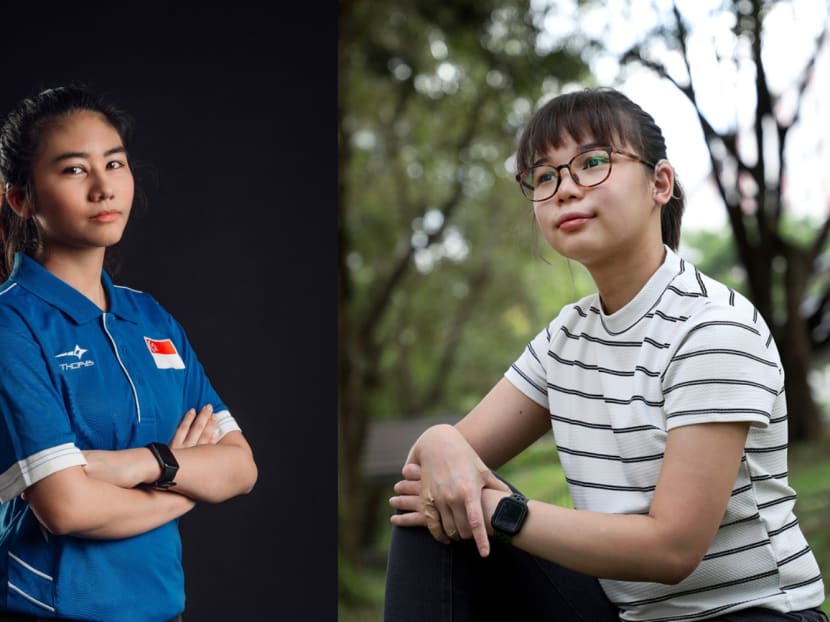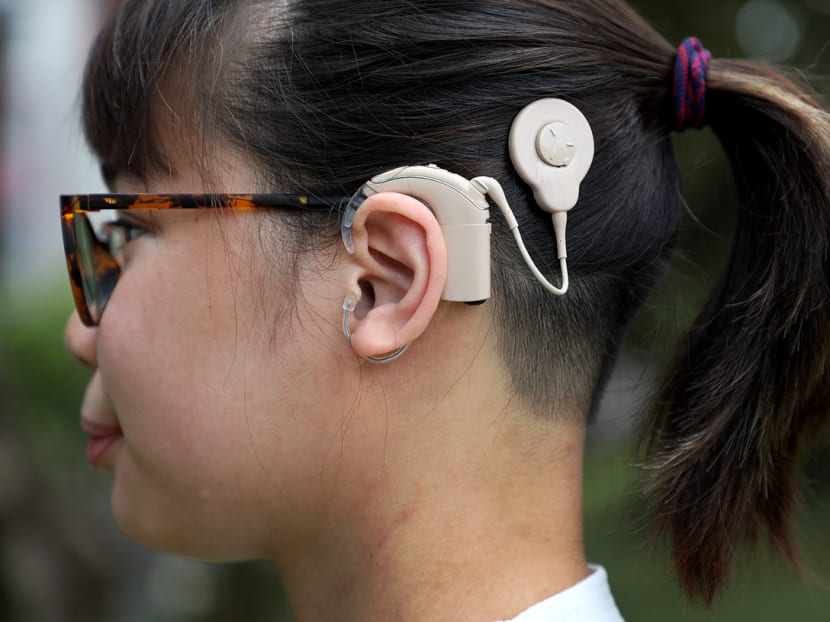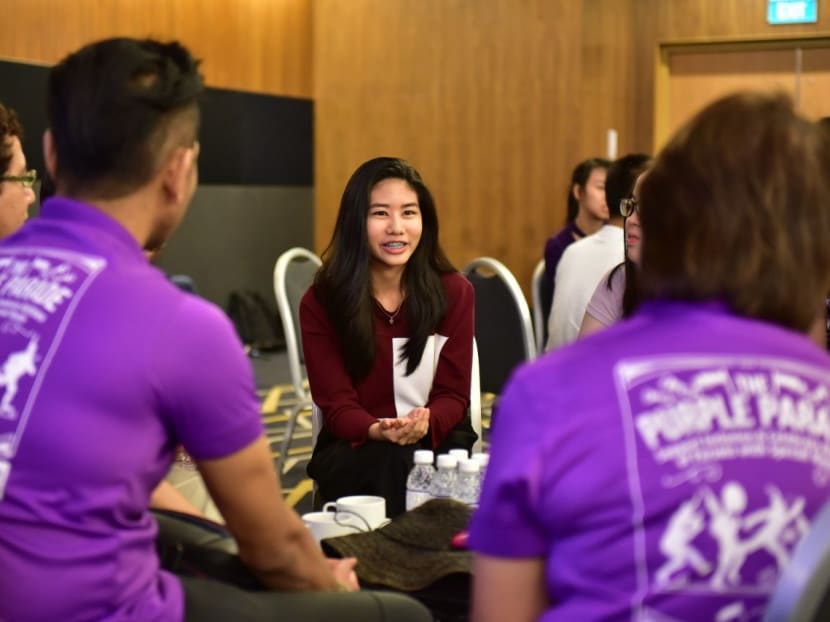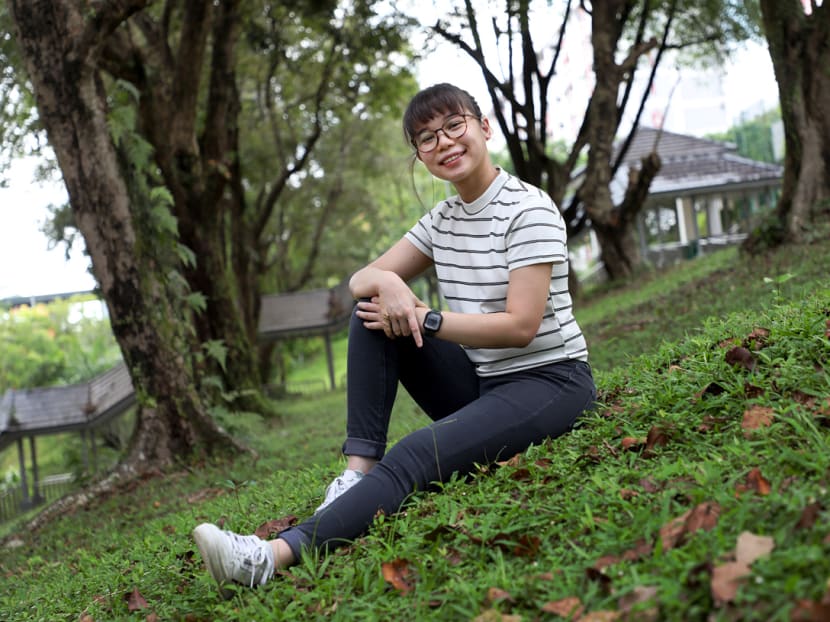‘Fear and courage walk side by side’: They are young, deaf and want to be heard
SINGAPORE — One was diagnosed with hearing problems three days after birth and the other, when she was four years old. Both grew up with profound hearing loss, were teased and made to feel like misfits by schoolmates, but these have not stopped the two Singaporeans from making good of their goals.

Miss Adelia Naomi Yokoyama (left) and Miss Clydia Tan (right), who have had profound hearing loss from a young age, want to encourage young people with hearing impairment to believe in themselves despite the challenges they face.
- Two young Singaporeans with profound hearing loss talk about the hurdles, discrimination and stigma they faced
- Having cochlear implants helped them to learn to listen and speak
- They want people to know that not all people with hearing loss communicate the same way
- One of them is waiting to join the workforce as a nurse
- The other is a bowling champ who will be representing Singapore at the Deaflympics in Brazil in 2022
SINGAPORE — One was diagnosed with hearing problems three days after birth and the other, when she was four years old. Both grew up with profound hearing loss, were teased and made to feel like misfits by schoolmates, but these have not stopped the two Singaporeans from making good of their goals.
Miss Clydia Tan, 23, is embarking on a career once thought to be “unsuitable” for deaf individuals. She graduated with a degree in nursing from the National University of Singapore last year and may soon join the healthcare workforce in its Covid-19 fight once she obtains her nursing licensure.
Miss Adelia Naomi Yokoyama, 22, clinched Singapore’s first Deaflympics gold medal in 2017 and is training hard for the next competition in Brazil next year.
Held every four years, the Deaflympics is organised by the International Committee of Sports for the Deaf.
The two young women told TODAY that the hurdles they have faced have made them stronger.
“Having an impairment doesn’t limit one’s life experience,” Miss Yokoyama said.
“In my journey, I have experienced how fear and courage sometimes walk side by side. It is important to be our own hero and believe in ourselves.”
At the same time, because they have both learnt to speak, Miss Tan said that this can make people like them feel like they are in a “limbo”, because they do not belong among those who have no hearing problem but they also do not fully identify with the culture of the hearing-impaired since they can speak and their primary language is not sign language.
The misconception that all deaf people communicate by signing is something Miss Tan hopes to address.
“Hearing loss exists on a fluid spectrum and there is no ‘one way’ to be deaf. Every individual with hearing loss has his or her preferences for communicating and this should be respected, the same way I respect you as a person, no matter your race,” she said.
ALONE AMONG HEARING PEOPLE
Miss Tan was diagnosed with sensorineural hearing loss in both ears at four years old but only underwent cochlear implant surgery last year.
Due to profound hearing loss in her left ear, she relied mainly on her right ear, which had some residual hearing, while growing up.
It is not known what caused her hearing loss. By the time she was diagnosed, Miss Tan could speak words and simple sentences.
She had her education in mainstream schools and was raised using the natural auditory-oral approach, where her residual hearing was used to learn and train speech via intensive speech therapy and the use of a hearing aid.
“It was a strong belief of my parents, particularly my mother, that I was treated no differently from any other child. She wanted to give me a chance at mainstream education, an experience she thought would benefit me in the long run,” Miss Tan said.
However, she recalled spending most of her early school years struggling to keep up with her hearing peers, who teased her for wearing a hearing aid in school.
She recalled: “To cope, I would take any opportunity not to use my hearing aid. Later, I had assistive devices such as a transmitter to help me understand speech during lessons.
“Some teachers would refuse to wear it due to its bulky nature or because they were already using personal microphone and believed it was sufficient for me to hear.”
The FM transmitter used by the teacher minimised background noises to make speech clearer and easier to hear via a receiver. Most transmitters came with a lanyard and may be clipped onto clothing.
Adding to the girl’s stress were the speech therapy lessons outside school.
“Though the sessions benefited me in the long run, the pressures of integrating into the hearing community took its toll on me mentally and emotionally. It was one of the first few traumatic experiences I had as a growing child and its effects on me became apparent when I would refuse to speak for fear of being corrected,” Miss Tan said.
She was later transferred to the Canossian School, previously known as Canossian School for the Hearing Impaired, where specialised support is given to children with hearing impairment.
UNKIND WORDS
Diagnosed with profound hearing loss in both ears at three days old, Miss Yokoyama recalled similar unpleasant experiences while growing up.
Although her childhood was packed with many fun moments with her loving family, she said that it was not easy growing up with a hearing impairment.
“I guess the agenda of ‘diversity and inclusion’ is still a work in progress for our Singapore community. As much as I was surrounded by kind and caring people, I have also crossed paths with people who forget I have emotions and feel hurt when unkind words are used,” she said.
She has been called “deaf” in a derogatory tone and labelled “stupid”. Awkward moments occur when people talk about her, thinking that she cannot hear them.
“People stare at my speech processors and say things like, ‘Hey, look, this girl is an alien from outer space’. It hurts me when people see me as someone who is different from them, as though I am an outcast,” Miss Yokoyama said.
Her parents and two older sisters, who have normal hearing, played a big role in building her confidence.
HEARING AIDS ARE NOT A CURE
Getting hurt by insensitive comments is not uncommon among people with hearing impairment. Often, low public awareness fuels misconceptions and discrimination.
To raise awareness, Miss Tan and four friends from Canossian School recently started an advocacy project called 5GirlsTheory. On YouTube, the channel aims to offer a safe space for the deaf and hard-of-hearing, and to inform the public on how to be more inclusive and encouraging towards those with hearing loss.
“I feel that it is an Asian trait (to have) the need to want to find a ‘cure’, to fix what is ‘broken and spoilt’,” Miss Tan said.
“Some people believe that if I’m using a hearing device, my hearing loss is ‘cured’. What they fail to understand is that the hearing aid is just an amplification device – sounds are made louder but without auditory clarity, the words still sound muffled.”
An example would be music or songs played in a mall. Although Miss Tan can hear the music, she cannot hear the lyrics because of the background noises.
Miss Tan said that she is almost always on “heightened alert” and compensates for the lack of clarity in hearing with contextual cues, such as lip-reading and body language.
This has been made more difficult by the use of masks during the Covid-19 pandemic, which muffles the voice and takes away visual cues.
Miss Tan — who has two older sisters, both with normal hearing — did not have many friends from the hearing or the deaf community. The four girls with whom she started 5GirlsTheory were her first close friends.
Now, her circle of friends includes a mix of individuals with hearing loss, other disabilities as well as abled individuals.
BABIES BORN WITH HEARING LOSS
Dr Barrie Tan, senior consultant and ear, nose and throat (ENT) specialist surgeon at Barrie Tan ENT Head and Neck Surgery, said that around four in every 1,000 babies in Singapore — or around 150 children — are born with some form of hearing impairment every year, of whom more than 60 will have significant hearing loss.
The most common cause is congenital sensorineural hearing loss, which is damage to the inner ear and nerves that transmit sound signals to the brain. This is due to genetic abnormalities and malformations of various parts of the ear, Dr Tan said.
Children can also develop hearing loss after birth. This may be due to causes such as severe and long-lasting middle-ear infections, certain illnesses including meningitis, measles and chickenpox, head injuries and excessive exposure to very loud noises.
However, access to advance hearing interventions have levelled the field, even for people with hearing loss that cannot be helped with normal hearing aids.
For example, surgery is available for certain patients with abnormalities of the outer and middle ear, which affect regular transmission of sound waves, Dr Tan said.
For those with sensorineural hearing loss, which is irreversible, cochlear implantation technology is now a way to restore lost hearing, he added.
HEARING AGAIN
Both Miss Tan and Miss Yokoyama received cochlear implants. The devices are surgically implanted in the inner ear (cochlea) to stimulate the hearing nerve directly, without the need for functioning cochlear hair cells.
An external sound processor is worn behind the ears to pick up sounds and transmit them as electrical signals to the internal implants.

Associate Professor Low Wong Kein, senior consultant at Novena ENT – Head and Neck Surgery Specialist Centre, said that a cochlear implant is considered when the patient is left with so few functional cochlear hair cells that hearing aids cannot offer adequate benefit.
“In the past, we only implanted those with (severe to profound) hearing loss in both ears. In recent years, even patients with single-sided deafness may be suitable candidates,” Assoc Prof Low said.
He has performed cochlear implant surgery in children as young as six months old.
Advances in cochlear implant technology mean that the newer models are more visually discreet, lighter and even more high-tech than its predecessors.
For example, the latest cochlear implant sound processor on the market offers direct streaming from compatible Apple or Android digital devices, allowing the user to stream the audio component of videos or calls directly into the ear.
Still, for optimal outcomes, Assoc Prof Low said that implant recipients need time and proper rehabilitation to adapt to sounds.
The experts said that hearing loss should be treated as soon as possible to restore hearing.
This is especially important for children born with or who develop hearing loss at a young age, before their speech and language capabilities are fully developed.
“Essentially, you need to listen well in order to speak well, because we speak out and imitate what we hear. Without good hearing, then whatever little the child hears will translate into poor speech,” Dr Tan explained.
“The older the child, the less pliable the brain is in learning. It is ultimately the brain that hears and learns,” he added.
Not all patients are suitable to get cochlear implants. They include people with absent or damaged hearing nerves and those with serious medical conditions that render general anaesthesia too risky, Assoc Prof Low said.
“Care is also exercised in certain groups. For example, those who had lost their hearing for many years.
“The hearing nerve would have degenerated and the brain would have lost its plasticity to adapt to new sounds, resulting in limited post-implant benefits, such as hearing of only environmental sounds,” Assoc Prof Low said.
NEW OPPORTUNITIES
Receiving cochlear implants have benefited the two young women.
Miss Yokoyama said that she is thankful for the opportunity to interact with people around her and to lead an enriching life.
She received her first cochlear implant when she was around two years old; the second one at 10 years old.
“I guess that is how long my parents needed to save up,” she said.
Assoc Prof Low said that a cochlear implant device can cost at least S$40,000, excluding the surgery and hospitalisation. Subsidies are available for some children.

Miss Yokoyama said: “The implant helped me to listen and speak. Being able to interact, communicate and connect with people of different abilities and challenges bring me lots of joy.”
Recently, she shared her personal story as part of the Achieve Anything programme. She is the first person in Singapore with hearing loss to do so.
The global programme is organised by the not-for-profit Cochlear Foundation and Malala Fund to raise awareness on the barriers preventing children and young people with hearing loss from getting access to education and realising their full potential.
The Malala Fund was founded by Miss Malala Yousafzai, 24, the world’s youngest Nobel Peace prize laureate and an education activist.
Miss Yokoyama started bowling competitively in Secondary 1 after falling in love with the sport in primary school. She now trains three to four times a week.
“Hitting the pins and listening to them fall is like music to my ears. Delivering a good shot is magical,” she said.
“I love the whole challenge about bowling. No two games are the same. It is the ability to think, feel, analyse, reflect, and to stay calm and composed that makes bowling an adventure.”
MAKING SENSE OF NEW SOUNDS
Miss Tan took the plunge to get a cochlear implant in her left ear last year as her residual hearing had become increasingly unstable.
After not using her left ear for two decades, the chance of achieving good quality hearing after the surgery was not high but it was a risk that she was willing to take.
“It was a no-brainer decision for me because I was not ready to give up five years of nursing studies after what I went through, fighting through two years to obtain a letter of conditional licensure,” she said.
The process of applying for a licensure usually takes a few months for most people, Miss Tan said. It took her two years to receive a conditional offer due to her hearing condition, she added.
To get through her studies, she had relied heavily on a notetaker for lectures and tutorials, as well as an assistive device to stream her lecturers’ voice directly into her hearing aid.

Miss Tan recalled the slightly “anti-climactic” experience after her cochlear implant was turned on, partly because she could not make sense of what she was hearing.
Her rehabilitation required her to re-learn sounds and match them to their source.
“Now that I’m one year in, I’m really glad I stuck it out. I am now able to hear a lot more sounds that I would not have caught with my fluctuating hearing on my right side.”
She is now able to hear using a landline telephone, something that was not easy to catch because of background noises, and she would also get feedback sounds from her hearing aid. If the environment is quiet, it would be easier, but this is not usually the case in hospital wards, for instance.
“This is a huge milestone for me considering that was one of the major tasks I struggled with during my nursing placements and my main concern when I start work in the future,” she said.
While her foray into healthcare has been daunting at times, Miss Tan said that the journey has been rewarding.
To deaf individuals chasing their dreams, she said: “If you are among the first few in your field, make it count. There are many of us backing you up.”






